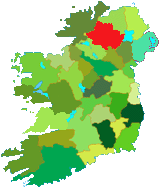



|
Ulster History Park.Omagh County Tyrone |
Sell almost anything here.
|
| |
| The
Ulster History The Ulster History Park must not to be confused with The Ulster American Folk Park, also located in County Tyrone. The History Park has many fine reconstructions of settlements and dwellings, from ancient stone age dwellings and tombs, a Crannóg which is essentially a fortified dwelling in a lake, these were abundant in Ireland around 5,000 tears ago, many of which can be seen today. There is a Rath which was again a fortified dwelling, but these would be set usually on a small hilltop. Almost everyone in early times lived in Rath's each would in all possibility been occupied by a family unit, many of these can also be seen today as circles of trees and shrubs on hilltops across Ireland.
, a farming homestead known as a Rath (from around the
same time), an early Christian monastic settlement and a Motte and Bailey
castle typical of the early middle ages, and round tower, of Norman style.
Open the door to the past and take a walk around 10,000 years of history. From Stone Age camp to sophisticated manor dwelling, the story of Irish settlement is told on a grand scale at the Ulster History Park. The open-air museum traces the influx of migrants to Northern Ireland from 8,000BC. Visitors can tour fourteen full-scale reconstructions of homes and monuments set out in chronological order at the thirty-five acre site. Tony Candon, manager, said: "The Park presents aspects of the settlement history of Ulster from Mesolithic times to the Plantation of Ulster in the early Seventeenth century. In some instances the reconstructions were based on individual sites, in other cases the generic form was represented." The varied structures illustrate the building styles of different eras and hint at the conditions faced by the communities housed inside. The tour begins with a Mesolithic camp from around 8,000BC.
Tony said: "The first settlers were hunters and gatherers, a way of life that lasted in Ireland for about 4,000 years. They lived a fairly transient existence, moving about from place to place as food supplies became scarce here and plentiful there. Because they were not settled in one place, their dwellings were simple. The huts in the Ulster History Park are based on evidence excavated at Mount Sandal, near Coleraine, County Londonderry." Reconstructions of Neolithic houses and tombs demonstrate how society changed later in the Stone Age. Tony said: "Three things distinguish the Neolithic period from the age before, specifically, farming, the use of pottery and a settled way of life. The earliest evidence for farming anywhere in the British Isles comes from County Tyrone around 4,600 BC. Ireland was thickly wooded and farmers had to clear the forests to create fields to graze cattle and sheep and to cultivate wheat and barley." Later dwellings displayed at the Park include many from the Early Christian Period, such as farming homestead called a Rath and a defensive island settlement called a Crannog. The next stage of architectural development is shown by a Motte and Bailey Castle, a design brought by the invading Normans. Tony said: "There are some 350 mottes in Ireland, most of them in areas conquered by the Normans. They were strategically located to defend territories. New motte and bailey castles ceased to be built after the year 1230." Pictures courtesy of Ulster History Park: Novtombtour.jpg A seventeenth century plantation settlement, complete with working corn mill, is the final example of historic housing. Tony said: "After the Gaelic Irish of Ulster were conquered at the beginning of the seventeenth century, large tracts of land were confiscated by the crown and granted to new settlers from Scotland and England. These Planters established new towns in Ulster. Many settlements consisted of several stone and timber-framed houses built close to a large, strongly defended main house called a bawn." Throughout the site, vast stone monuments stand in testimony to the engineering skill of early settlers. The Park houses stone tombs, stone circles, single standing stones and an impressive stone dolmen. Tony said: "The tripod portal dolmen is, for many people, the classic image of a megalithic tomb. The tombs may date back to around 4,000 to 3,500 BC. The one at Legananny, County Down, is probably the best known in Northern Ireland. Both cremated and inhumed remains have been found in the small number that have been excavated." Eric Montgomery, secretary of the Scotch Irish Trust of Ulster, first raised the idea of the Park in 1982. Work began at the site in 1985 with Omagh District Council as the owner and developer. The Park was officially opened in 1990. Tony said: "We now have an exhibition gallery and audio-visual theatre alongside the main Park. We run an on-going programme of events, details of which are posted on our website, and some thirty thousand people visit each year." |
||
The
Ulster History Park Cullion, Lislap Omagh, County Tyrone Northern Ireland
BT79 7SU Tel: 028 8164 8188 |
|